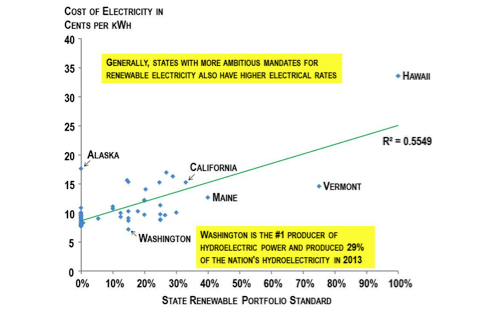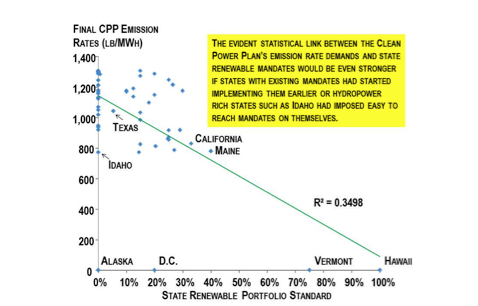For the past century or so, those who believe in the unbridled power of government have broken down the Constitution’s restraints on federal commerce power, hijacking the regulatory machinery of state government towards their ends. This assault on state autonomy is known as “cooperative federalism.” As Mario Loyola noted in a March 2014 piece in National Review, cooperative federalism has two ends: to “expand federal power” and to “protect states with uncompetitive policies.”
The latest example of using cooperative federalism to protect states with uncompetitive policies is the Environmental Protection Agency’s Clean Power Plan. The plan, which a number of states have sued the federal government over, sets state goals for pounds of carbon dioxide equivalents emitted per megawatt hour of electrical generation.
Of course, the Clean Power Plan hits some states far harder than others.
America’s power generation mix was largely developed along the lines of what was available locally. Some regions are flat and have abundant coal; other areas, such as the Northwest, have plenty of large rivers and mountains that allow for hydroelectric power. Beginning in the 1970s, California’s power generation was shaped by the need for cleaner air, its mountains and cold Pacific current acting to trap air pollution close to heavily populated areas.
In time, electrical power generation came to be influenced by interests that demanded increased quotas for renewable power. More expensive and less reliable than fossil fuels, renewable power such as wind, solar, biomass and small hydro couldn’t compete without subsidies or mandates.
To create a market, special interests asked politicians for mandates (in this case, renewable portfolio standards) and, as of this year, 29 states and Washington, D.C. have enacted mandates. These mandates range from Hawaii’s (that 100 percent of electricity come from renewables by 2045) to Iowa’s (that 105 megawatts of capacity come from renewables, about 0.65 percent of total power). Eight states have unenforceable goals and 13 states have no mandates or goals whatsoever.
But these mandates come at a cost. The figure below displays the cost of electricity in 2014 matched up to renewable mandate policies in the 50 states, showing a robust correlation with an r-squared of 0.5549. The bottom line: it isn’t easy being green—it’s downright costly.

Loyola writes that states, not the federal government, were meant to have the preponderance of regulatory power under our Constitution, but that “intense interstate competition” would serve as a break on overzealous regulation or taxation in a state. He writes that since “people and capital could always move to another state, its comparative disadvantage would probably make the policy unsustainable over the long term. The progressives’ solution was to nationalize the desired levels of spending and regulation.”
That brings us back to the EPA’s Clean Power Plan, which simply nationalizes renewable energy mandates across the nation. The figure below shows the correlation between the Clean Power Plan’s final emission rates per megawatt hour of electricity produced in a state to each state’s renewable mandate. The correlation, while noticeable, would even be stronger had states with abundant hydropower, such as Idaho, set for themselves easy-to-reach renewable mandate goals while other states with high mandates were a little further along in implementing them.

The bottom line is that the Clean Power Plan nationalizes regulation of electrical power generation, imposing higher costs on most states, other than the small number that have abundant hydroelectric dams, most of which were built in the age before environmental permitting and interminable lawsuits. The EPA’s Clean Power Plan imposes California’s electricity costs—costs California politicians levied on their own constituents—on most of the rest of the nation, which will result in soaring electric bills.
Chuck DeVore is a vice president with the Texas Public Policy Foundation. He served in the California State Assembly from 2004 to 2010.